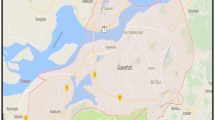Abstract
With the development of modern geography, new requirements have been put forward for traditional geography teaching. Based on the implementation of secondary school geography teaching in China, and a case of application of ArcGIS in the practice of map teaching, the present work analyzes how to build the geographic information literacy and innovation ability of secondary school students by using the ArcGIS geographic information system software, and puts forward some recommendations, including (1) the compilation of ArcGIS teaching materials suitable for teachers and students’ characteristics; (2) the research and development of ArcGIS software for the secondary school education; and (3) the enhancement of ArcGIS training for secondary school geography teachers. It is hoped that the application of ArcGIS software can promote the development of geography teaching and provide modern teaching methods for secondary school geography. With the maturing of ArcGIS software it will become more popular among secondary school geography teachers, a development which will certainly take geography teaching in China’s secondary schools to a whole new level.



Similar content being viewed by others
References
Chen, S. P. (1987). Geographical data handling and GIS in China. International Journal of Geographical Information System, 1(3), 219–228.
Shupeng, C., & van Genderen, J. (2008). Digital Earth in support of global change research. International Journal of Digital Earth, 1(1), 43–65.
Stork, E. J., Sakamoto, S. O., & Cowan, R. M. (1999). The integration of science explorations through the use of Earth images in middle school curriculum. IEEE Transactions on Geoscience and Remote Sensing, 37, 1801–1817.
Fan, J., Xu, Y. D., Chen, C., et al. (2001). The study on geography of elementary education in China—includes goals and content-structure of the geographical curriculum standard for middle school in China. Geographical Research, 20, 527–536.
Sun, J., Pan, Y. J., Tang, M. L., et al. (2013). Retrospect and prospect of Geographical Sciences in China: A comparison with the strategic directions for geography in the USA. Journal of Geographical Sciences, 23, 963–977.
Li, W. Z., Lin, F., Zhou, J. L., et al. (2015). DTN routing with fixed stations based on the geographic grid approach in an urban environment. Wireless Personal Communications, 82(4), 2033–2049.
Benjamin, J., Rovere, A., Fontana, A., et al. (2017). Late quaternary sea-level changes and early human societies in the central and eastern Mediterranean Basin: An interdisciplinary review. Quaternary International, 449, 29–57.
Korucu, M. G. (2012). GIS and types of GIS education programs. Procedia Social and Behavioral Sciences, 46, 209–215.
Frankl, A., Zwertvaegher, A., Poesen, J., et al. (2013). Transferring google earth observations to GIS-software: example from gully erosion study. International Journal of Digital Earth, 6(2), 196–201.
Wu, L., Zhu, C., Zheng, C. G., et al. (2014). Impact of Holocene climate change on the prehistoric cultures of Zhejiang region, East China. Journal of Geographical Sciences, 24(4), 669–688.
Wu, L., Zhu, C., Zheng, C. G., et al. (2014). Holocene environmental change and its impacts on human settlement in the Shanghai Area, East China. CATENA, 114, 78–89.
Temirbekov, A., & Yesnazarova, U. (2013). Globalization, regionalization and objectives of geographical education. Procedia Social and Behavioral Sciences, 89, 422–424.
Han, S. W. (2010). Research on the vector WebGIS realization based on SVG. Science of Surveying and Mapping, 35(2), 193–196.
Han, S. W. (2010). Realization of special map on vector WebGIS based on SVG. Science of Surveying and Mapping, 35(5), 233–235.
Wu, L., Li, F., Zhu, C., et al. (2012). Holocene environmental change and archaeology, Yangtze River Valley, China: Review and prospects. Geoscience Frontiers, 3(6), 875–892.
Wu, L., Liu, H. Y., & Peng, P. (2014). Application of remote sensing in training geospatial cognitive abilities of secondary students. International Journal of Online Engineering, 10(2), 47–51.
Norman, K., Inglis, J., Clarkson, C., et al. (2018). An early colonisation pathway into northwest Australia 70–60,000 years ago. Quaternary Science Reviews, 180, 229–239.
Shen, S., Shen, Z. R., & Zhao, M. (2017). Predict brain MR image registration via sparse learning of appearance and transformationBig data monitoring system design and implementation of invasive alien plants based on WSNs and WebGIS. Wireless Personal Communications, 97(3), 4251–4263.
Romoozi, M., Fathy, M., & Babaei, H. (2015). A content sharing and discovery framework based on semantic and geographic partitioning for vehicular networks. Wireless Personal Communication, 85(3), 1583–1616.
Oshima, H. (2015). GIS specialists’ support for geography education. International Perspectives in Geography, 3, 163–171.
Acknowledgements
The authors acknowledge the Open Research Fund of Key Laboratory of Digital Earth Science, Institute of Remote Sensing and Digital Earth, Chinese Academy of Sciences (Grant: 2015LDE012), the National Natural Science Foundation of China (Grant: 41771221), and the Major Research Project of Education Transformation in Anhui Province (Grant: 2015zdjy036).
Author information
Authors and Affiliations
Corresponding author
Rights and permissions
About this article
Cite this article
Wu, L., Li, L., Liu, H. et al. Application of ArcGIS in Geography Teaching of Secondary School: A Case Study in the Practice of Map Teaching. Wireless Pers Commun 102, 2543–2553 (2018). https://doi.org/10.1007/s11277-018-5276-6
Published:
Issue Date:
DOI: https://doi.org/10.1007/s11277-018-5276-6




